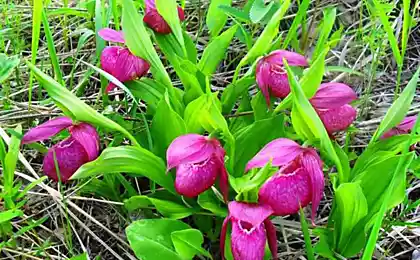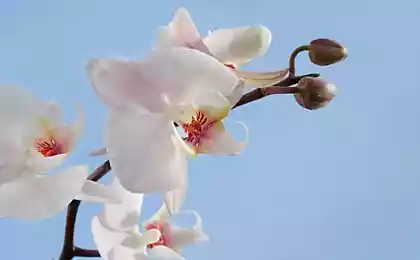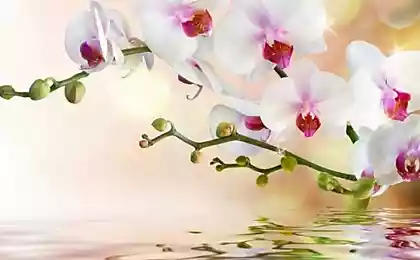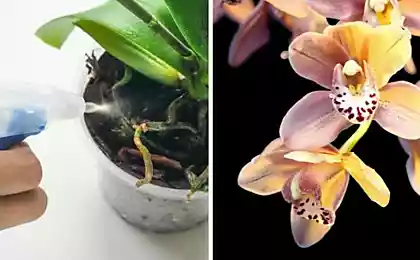207
Experienced flower growers answer the question why a capricious orchid refuses to bloom
Beautiful and healthy flowering of the orchid at home is determined by many factors. Today we will tell you about the main points thanks to which your orchid will bloom for a long time and please your eye.
Many ladies adore the orchid for its tenderness, grace and amazing ability to fit into any interior. There are so many reasons for sadness and anxiety in the world today. So I want the house was more of those things that please the eye and cheer up. Beautiful homemade orchids can definitely make the list.

GettyImages Phalaenopsis is very sensitive to large amounts of water. Excessive watering will definitely make the plant capricious. Especially critical is too abundant watering, when the roots suffer from some parasites. For them, all this water will be an ideal breeding ground. In this case, the magnificent flowering of the phalaenopsis, you will definitely not wait.

It is also worth considering that orchids are very react poorly to a pot shift. They, poor things, just got used to the native place, and the hostess already takes them somewhere. You shouldn't do that. So, what should you consider when choosing a permanent residence for your orchid?

Now is a particularly dangerous period, because the sun does not seem to warm much, but its direct rays can leave the sun behind. Heat burns on the leaves of your beautiful orchid. Try to put the pot where there will be enough light, but the plant will rarely get under direct sunlight.

GettyImages Look at the leaf pigmentation. If in some places they acquire a pink or purple tint, then the flower has enough light with excess. It happens sometimes, if the pot is at the south window. It should be covered with curtains or Roman curtains. Windows in other directions do not need such manipulation.

GettyImages We've learned how to define over-lighting. What happens to the leaves in case of deficiency? They usually become elongated, narrow and pale. The plant begins to pull these stunted leaves upwards, as if trying to find at least one ray of light.
First, an important point that can cause problems with flowering, can be excessively high room temperature, as well as lack of ventilation. That is why you should not place pots with a plant near heating devices. You should also ventilate the room from time to time, avoiding drafts.

GettyImages Secondly, do not forget about feeding phalaenopsis. The best fertilizers are those that contain a lot of phosphorus and potassium. But a lot of nitrogen orchids do not like. Also, do not forget about the presence of useful trace elements in chelate form.
Of course, it is also important to use the right substrates when transplanting orchids. The fact is that in the wild orchids are usually hooked by roots at some point of support. The ground around the roots is usually loose, which ensures good air exchange.
Tell us about how you care for your orchids and what life hacks you can tell our readers!
Photo in article and preview GettyImages.
Many ladies adore the orchid for its tenderness, grace and amazing ability to fit into any interior. There are so many reasons for sadness and anxiety in the world today. So I want the house was more of those things that please the eye and cheer up. Beautiful homemade orchids can definitely make the list.

GettyImages Phalaenopsis is very sensitive to large amounts of water. Excessive watering will definitely make the plant capricious. Especially critical is too abundant watering, when the roots suffer from some parasites. For them, all this water will be an ideal breeding ground. In this case, the magnificent flowering of the phalaenopsis, you will definitely not wait.

It is also worth considering that orchids are very react poorly to a pot shift. They, poor things, just got used to the native place, and the hostess already takes them somewhere. You shouldn't do that. So, what should you consider when choosing a permanent residence for your orchid?

Now is a particularly dangerous period, because the sun does not seem to warm much, but its direct rays can leave the sun behind. Heat burns on the leaves of your beautiful orchid. Try to put the pot where there will be enough light, but the plant will rarely get under direct sunlight.

GettyImages Look at the leaf pigmentation. If in some places they acquire a pink or purple tint, then the flower has enough light with excess. It happens sometimes, if the pot is at the south window. It should be covered with curtains or Roman curtains. Windows in other directions do not need such manipulation.

GettyImages We've learned how to define over-lighting. What happens to the leaves in case of deficiency? They usually become elongated, narrow and pale. The plant begins to pull these stunted leaves upwards, as if trying to find at least one ray of light.
First, an important point that can cause problems with flowering, can be excessively high room temperature, as well as lack of ventilation. That is why you should not place pots with a plant near heating devices. You should also ventilate the room from time to time, avoiding drafts.

GettyImages Secondly, do not forget about feeding phalaenopsis. The best fertilizers are those that contain a lot of phosphorus and potassium. But a lot of nitrogen orchids do not like. Also, do not forget about the presence of useful trace elements in chelate form.
Of course, it is also important to use the right substrates when transplanting orchids. The fact is that in the wild orchids are usually hooked by roots at some point of support. The ground around the roots is usually loose, which ensures good air exchange.
Tell us about how you care for your orchids and what life hacks you can tell our readers!
Photo in article and preview GettyImages.
How to protect messages in Telegram so that no one reads them
Why you can't let anyone sit on your bed in street clothes























